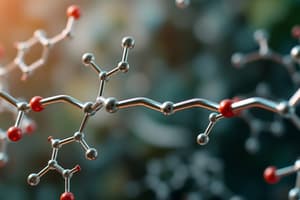Podcast
Questions and Answers
What is the purpose of the polar modulus in torsion analysis?
What is the purpose of the polar modulus in torsion analysis?
- To relate the torque applied to the material with the shear stress (correct)
- To calculate the maximum axial load a shaft can withstand
- To determine the total energy stored in the material
- To measure the shear strain in a solid circular shaft
In the context of solid and hollow circular shafts, which factor primarily influences the torsional strength?
In the context of solid and hollow circular shafts, which factor primarily influences the torsional strength?
- Length of the shaft
- Surface finish of the shaft
- Material elasticity
- Outer diameter and wall thickness (correct)
When analyzing a closed coiled helical spring under axial load, what is the main consideration for calculating the spring's deflection?
When analyzing a closed coiled helical spring under axial load, what is the main consideration for calculating the spring's deflection?
- The inner diameter of the coil and coil pitch
- Material yield strength and diameter of the spring wire
- Temperature variations affecting material properties
- The number of active coils and the spring's physical dimensions (correct)
In the derivation of the torsion equation, which assumption is crucial for accurate results?
In the derivation of the torsion equation, which assumption is crucial for accurate results?
What is the primary effect of internal pressure on thin cylinders?
What is the primary effect of internal pressure on thin cylinders?
Flashcards are hidden until you start studying
Study Notes
Theory of Torsion & Assumptions
- Torsion is a twisting force applied to an object, resulting in shearing stress and strain.
- Assumptions for theory of torsion:
- The material is homogenous, isotropic, and linearly elastic.
- The shaft is circular in cross-section.
- The applied torque is constant along the shaft.
- The deformation is small compared to the dimensions of the shaft.
Derivation of Torsion Equation
- The torsion equation relates the applied torque to the shear stress and the geometry of the shaft.
- The torsion equation is: T = (π/16) * τ * d^3, where:
- T is the applied torque.
- τ is the shear stress.
- d is the diameter of the shaft.
Polar Modulus
- The polar modulus (J) represents the shaft's resistance to torsion.
- It is calculated as (π/32) * d^4 for a solid circular shaft and (π/32) * (D^4 - d^4) for hollow circular shaft, where D and d are the outer and inner diameters respectively.
Stresses in Solid and Hollow Circular Shafts
- The shear stress in a circular shaft is maximum at the surface and decreases linearly towards the center.
- For a solid shaft, the maximum shear stress is τ = (16 * T) / (π * d^3).
- For a hollow shaft, the maximum shear stress is τ = (16 * T) / (π * (D^4 - d^4)).
Power Transmitted by Shaft
- Power transmitted by a rotating shaft is calculated as P = (2π * N * T) / 60, where:
- P is the power transmitted in watts.
- N is the rotational speed in rpm.
- T is the torque in Nm.
Closed Coiled Helical Spring with Axial Load
- A closed coiled helical spring stores energy when subjected to an axial load.
- The deflection of the spring is proportional to the applied load.
- The spring constant is determined by the material properties, coil diameter, and wire diameter.
Thin Cylinders Subjected to Internal Pressure
- Thin cylinders subjected to internal pressure experience hoop stress, which is the stress acting circumferentially.
- This stress is calculated as σh= (P * d) / (2 * t), where:
- σh is the hoop stress
- P is the internal pressure
- d is the mean diameter of the cylinder
- t is the wall thickness
- Thin cylinders also experience longitudinal stress, which acts along the length of the cylinder.
- The longitudinal stress is equal to half of the hoop stress: σl = (P * d) / (4 * t)
Studying That Suits You
Use AI to generate personalized quizzes and flashcards to suit your learning preferences.




